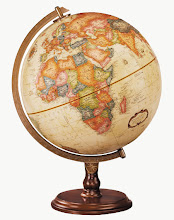We took the watershed route (also called the Patriarchal Highway) south to Bethlehem. Bethlehem is in the Palestinian controlled West Bank, so we crossed through the check-point in the concrete and barbed wire wall/fence that Israel has set up. Israeli tour guides don't take groups into Bethlehem anymore, claiming that the area is too dangerous, but this really isn't the case (at least, not at the moment). Unfortunately for Bethlehem, this has really slowed down their tourism industry.
The church in Bethlehem is from the 4th century, making it one of the oldest in the country. While most churches were destroyed when the Persians invaded, this church was saved because they noticed a picture of the Magi (thought to be from Persia) and decided not to destroy it. The entrance is through a small door - originally it was to keep Muslim looters from bringing in donkeys to help carry out the artifacts, now they say it's so everyone has to bend down and become humble. We had to wait for a few minutes before being allowed to enter the grotto and see "the place" were Jesus was born, then it was "quickly, quickly, keep moving" as we were rushed out the other side.

While standing in the square before entering the church, we learned a bit more about the Christmas story. two inaccurate translations have skewed the way we see the story. The first is the word "inn" (the same word is used later to describe the upper room used during the Last Supper) - it refers to a public room, in either a private residence or a public house. The second our idea of a stable. A number of residences in Bethlehem were built into caves - the front of the house was build, while the rear of the house was in the cave and often housed things such as bread ovens and the best breading animals (to keep them safe and use them as a source of warmth) and therefore feeding troughs. So, it's likely that Joseph went to the home of his relatives in Bethlehem, and was welcomed and allowed to stay in the front room with many of the other relatives in town for the census. And, when Mary went into labour, she went into the back room for privacy.

The fact that we celebrate Christmas in December also doesn't fit with what we know of the Biblical account of Jesus' birth. Winter is the time for growing crops in Israel (it's the rainy season), so the shepherds and their flocks stay in the wilderness where there is adequate food for the animals. In the spring, they move their flocks onto the fields - the sheep help the farmers by eating the stubble and fertilizing the fields. So since the shepherds were in the fields, it was probably May when Jesus was born.

Next stop was a hike up the Herodium - built by Herod the Great in 24 - 15 BC. It was built on a hill, then rock fill was poured around it to make the distinctive volcano shape. The walls were plastered to look like large stones, and the area was filled with lush plants. In the 66 /67 AD revolt, the Jews took control of the palace, changing the dining room into a synagogue. And later, it was used as a monastery. From the top, we had an excellent view into the Judean wilderness, and see how Jerusalem is hidden by the higher hills that surround it. There were pools of water at the base of the hill, and servants hauled water up to the large cisterns. Leaving the summit, we climbed down through the cisterns and the tunnels connecting them.

We stopped at Ramat Rahel ("Heights of Rachel") for lunch. The ridge route runs below the lookout, which overlooks the Rephaim Valley. There were also ruins of an eighth century BC royal palace never mentioned in the Bible, and piles of pottery that we could comb through for the perfect piece to take home as a souvenir.

Our last activity for the day was a walk down the Mount of Olives. We started at Dominus Flevit, a chapel with an awesome view of the Old City. At some graves near the gate we discussed burial practices at the time of Jesus' death. The picture we always see at Easter of an angel sitting on a round stone isn't an accurate depiction of the tomb that Jesus would have been buried in. During that time, the entrance to the tomb would have been square, and a stone plug (weighing about 300 lbs) would have been put into the opening. The term "rolling stone" was a carry-over from much earlier in history, when stones had been rolled in front of the openings for graves.
This chapel commemorates the supposed location where Jesus wept over Jerusalem. As Jesus came down the mountain, the crowds were waving palm branches - a symbol of the Hasmonean revolt in 141 BC, when the Maccabees defeated the Greeks and the temple was purified. Jesus entering this was therefore making the Pharisees nervous - the people were hoping for a revolution and the Pharisees must have know the danger the people were creating for themselves.

The final stop on the way down was the Garden of Gethsemane (meaning "oil press") were we went into the dark Basilica of the Agony, and across the road, Mary's Tomb.

We got back to the city early, so my roommate and I wondered through the old city for a while, looking in shops and sharing a giant bagel (with zatar to dip it into) before heading back to the hotel for the evening.



No comments:
Post a Comment